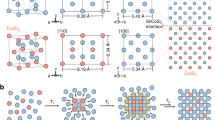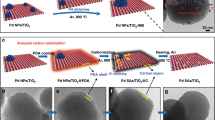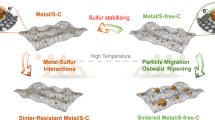Abstract
Heterogeneous conversion of CO2 to fuels by Si surface hydrides has recently attracted broad research interest. Being earth-abundant, low-cost and non-toxic, elemental Si is a very attractive candidate for this process, which targets CO2 conversion to synthetic fuels on a gigatonne-per-year scale. It is well known, however, that silicon hydrides react stoichiometrically with CO2, and all attempts have failed to achieve catalytic conversion. The problem originates from the formation of inactive silanols and siloxanes with permanent loss of Si hydrides. Here, we deposit Pd on the surface of Si nanosheets, aiming to address the core of the problem. An operando infrared study shows Si hydrides successfully regenerating on such surfaces exposed to CO2 and H2. We demonstrate that silicon–hydride nanosheets decorated with Pd nanoparticles can enable the reverse water–gas shift reaction in a catalytic cycle.
This is a preview of subscription content, access via your institution
Access options
Access Nature and 54 other Nature Portfolio journals
Get Nature+, our best-value online-access subscription
$29.99 / 30 days
cancel any time
Subscribe to this journal
Receive 12 digital issues and online access to articles
$119.00 per year
only $9.92 per issue
Buy this article
- Purchase on Springer Link
- Instant access to full article PDF
Prices may be subject to local taxes which are calculated during checkout





Similar content being viewed by others
Data availability
The data that support the findings of this study are available from the corresponding author upon reasonable request.
References
Faunce, T. A. et al. Energy and environment policy case for a global project on artificial photosynthesis. Energy Environ. Sci. 6, 695–698 (2013).
Goeppert, A., Czaun, M., Jones, J.-P., Surya Prakash, G. K. & Olah, G. A. Recycling of carbon dioxide to methanol and derived products—closing the loop. Chem. Soc. Rev. 43, 7995–8048 (2014).
Rongé, J. et al. Monolithic cells for solar fuels. Chem. Soc. Rev. 43, 7963–7981 (2014).
Ozin, G. A. Throwing new light on the reduction of CO2. Adv. Mater. 27, 1957–1963 (2015).
Zubrin, R., Wagner, R. & Clarke, A. C. The Case for Mars (Free Press, New York, 2011).
Matsuo, T. & Kawaguchi, H. From carbon dioxide to methane: homogeneous reduction of carbon dioxide with hydrosilanes catalyzed by zirconium–borane complexes. J. Am. Chem. Soc. 128, 12362–12363 (2006).
Berkefeld, A., Piers, W. E. & Parvez, M. Tandem frustrated Lewis pair/tris(pentafluorophenyl)borane-catalyzed deoxygenative hydrosilylation of carbon dioxide. J. Am. Chem. Soc. 132, 10660–10661 (2010).
Riduan, S. N., Ying, J. Y. & Zhang, Y. Mechanistic insights into the reduction of carbon dioxide with silanes over N-heterocyclic carbene catalysts. ChemCatChem 5, 1490–1496 (2013).
Dasog, M. et al. Size vs surface: tuning the photoluminescence of freestanding silicon nanocrystals across the visible spectrum via surface groups. ACS Nano 8, 9636–9648 (2014).
Sun, W. et al. Heterogeneous reduction of carbon dioxide by hydride-terminated silicon nanocrystals. Nat. Commun. 7, 12553 (2016).
Wong, A. P. Y. et al. Tailoring CO2 reduction with doped silicon nanocrystals. Adv. Sustain. Syst. 1, 1700118 (2017).
Dasog, M., Kraus, S., Sinelnikov, R., Veinot, J. & Rieger, B. CO2 to methanol conversion using hydride terminated porous silicon nanoparticles. Chem. Commun. 53, 3114–3117 (2017).
Nakano, H. et al. Soft synthesis of single-crystal silicon monolayer sheets. Angew. Chem. Int. Ed. 45, 6303–6306 (2006).
Chandra, S., Masuda, Y., Shirahata, N. & Winnik, F. M. Transition-metal-doped NIR-emitting silicon nanocrystals. Angew. Chem. Int. Ed. 56, 6157–6160 (2017).
Zhang, Y. et al. Tunable metal/silicon hybrid dots catalysts for hydrocarbon selective oxidation. J. Phys. Chem. C 116, 20363–20367 (2012).
Albers, P., Pietsch, J. & Parker, S. F. Poisoning and deactivation of palladium catalysts. J. Mol. Catal. A 173, 275–286 (2001).
Martins, J. et al. CO2 hydrogenation with shape-controlled Pd nanoparticles embedded in mesoporous silica: elucidating stability and selectivity issues. Catal. Commun. 58, 11–15 (2014).
Daza, Y. A. & Kuhn, J. N. CO2 conversion by reverse water gas shift catalysis: comparison of catalysts, mechanisms and their consequences for CO2 conversion to liquid fuels. RSC Adv. 6, 49675–49691 (2016).
Ye, J., Ge, Q. & Liu, C. Effect of PdIn bimetallic particle formation on CO2 reduction over the Pd–In/SiO2 catalyst. Chem. Eng. Sci. 135, 193–201 (2015).
Wang, Z.-Q. et al. High-performance and long-lived Cu/SiO2 nanocatalyst for CO2 hydrogenation. ACS Catal. 5, 4255–4259 (2015).
Kunkes, E. L., Studt, F., Abild-Pedersen, F., Schlögl, R. & Behrens, M. Hydrogenation of CO2 to methanol and CO on Cu/ZnO/Al2O3: is there a common intermediate or not? J. Catal. 328, 43–48 (2015).
McKean, D. C. On the assignment of SiH and SiD stretching frequencies: a reanalysis of the ν7 bands of Si2H6 and Si2D6 and a harmonic local mode force field for disilane. Spectrochim. Acta A Mol. Spectrosc. 48, 1335–1345 (1992).
Benson, J. E., Kohn, H. W. & Boudart, M. On the reduction of tungsten trioxide accelerated by platinum and water. J. Catal. 5, 307–313 (1966).
Levy, R. B. & Boudart, M. The kinetics and mechanism of spillover. J. Catal. 32, 304–314 (1974).
Baumgarten, E. & Denecke, E. Hydrogen spillover in the system Pt Al2O3. I. Fundamental observations. J. Catal. 95, 296–299 (1985).
El-Sayed, A. M., Watkins, M. B., Grasser, T., Afanas'Ev, V. V. & Shluger, A. L. Hydrogen-induced rupture of strained SiO bonds in amorphous silicon dioxide. Phys. Rev. Lett. 114, 115503 (2015).
Jia, J. et al. Photothermal catalyst engineering: hydrogenation of gaseous CO2 with high activity and tailored selectivity. Adv. Sci. 4, 1700252 (2017).
Silaghi, M. C., Comas-Vives, A. & Copéret, C. CO2 activation on Ni/γ-Al2O3 catalysts by first-principles calculations: from ideal surfaces to supported nanoparticles. ACS Catal. 6, 4501–4505 (2016).
Bartolomé, J. et al. Magnetization of Pt13 clusters supported in an NaY zeolite: a XANES and XMCD study. Phys. Rev. B 80, 014404 (2009).
Ewing, C. S., Veser, G., McCarthy, J. J., Johnson, J. K. & Lambrecht, D. S. Effect of support preparation and nanoparticle size on catalyst–support interactions between Pt and amorphous silica. J. Phys. Chem. C 119, 19934–19940 (2015).
Di Paola, C., Pavan, L., D'Agosta, R. & Baletto, F. Structural stability and uniformity of magnetic Pt13 nanoparticles in NaY zeolite. Nanoscale 9, 15658–15665 (2017).
Dong, W. & Hafner, J. Dissociative adsorption on Pd(111). Phys. Rev. B 56, 15396–15403 (1997).
Liu, D., Gao, Z. Y., Wang, X. C., Zeng, J. & Li, Y. M. DFT study of hydrogen production from formic acid decomposition on Pd–Au alloy nanoclusters. Appl. Surf. Sci. 426, 194–205 (2017).
Johansson, M. et al. Hydrogen adsorption on palladium and palladium hydride at 1 bar. Surf. Sci. 604, 718–729 (2010).
Resch, C., Berger, H. F., Rendulic, K. D. & Bertel, E. Adsorption dynamics for the system hydrogen/palladium and its relation to the surface electronic-structure. Surf. Sci. 316, L1105–L1109 (1994).
Dong, W., Kresse, G. & Hafner, J. Dissociative adsorption of H2 on the Pd(111) surface. J. Mol. Catal. A 119, 69–76 (1997).
Leopold, K., Maier, M. & Schuster, M. Preparation and characterization of Pd/Al2O3 and Pd nanoparticles as standardized test material for chemical and biochemical studies of traffic related emissions. Sci. Total Environ. 394, 177–182 (2008).
Kresse, G. & Furthmüller, J. Efficient iterative schemes for ab initio total-energy calculations using a plane-wave basis set. Phys. Rev. B 54, 11169–11186 (1996).
Kresse, G. & Joubert, D. From ultrasoft pseudopotentials to the projector augmented-wave method. Phys. Rev. B 59, 1758 (1999).
Perdew, J. P., Burke, K. & Ernzerhof, M. Generalized gradient approximation made simple. Phys. Rev. Lett. 77, 3865–3868 (1996).
Grimme, S. Semiempirical GGA-type density functional constructed with a long-range dispersion correction. J. Comput. Chem. 27, 1787–1799 (2006).
Bučko, T., Hafner, J., Lebègue, S. & Ángyán, J. G. Improved description of the structure of molecular and layered crystals: ab initio DFT calculations with van der Waals corrections. J. Phys. Chem. A 114, 11814–11824 (2010).
Wang, Z., Selbach, S. M. & Grande, T. Van der Waals density functional study of the energetics of alkali metal intercalation in graphite. RSC Adv. 4, 4069–4079 (2014).
Acknowledgements
G.A.O. acknowledges financial support from the Ontario Ministry of Research and Innovation (MRI), the Ministry of Economic Development, Employment and Infrastructure (MEDI), the Ministry of the Environment and Climate Change’s (MOECC) Best in Science (BIS) Award, Ontario Center of Excellence Solutions 2030 Challenge Fund, Ministry of Research Innovation and Science (MRIS) Low Carbon Innovation Fund, Imperial Oil, the University of Toronto’s Connaught Innovation Fund (CIF), Connaught Global Challenge (CGC) Fund and the Natural Sciences and Engineering Research Council of Canada (NSERC). C.Q. and W.S. acknowledge the Connaught Fund and Department of Chemistry at the University of Toronto for funding. M.M. and C.V.S. acknowledge financial support in part by the Natural Sciences and Engineering Council of Canada (NSERC), University of Toronto, Connaught Global Challenge Award and Hart Professorship. The computations were carried out using University of Toronto computers and Compute Canada facilities, particularly SciNet and Calcul-Quebec. The authors acknowledge continued support from these supercomputing facilities. The authors thank X.Yan for helpful discussions on materials characterizations.
Author information
Authors and Affiliations
Contributions
C.Qian, W.S. and G.A.O. conceived and designed the experiments. C.Qian, W.S., D.L.H.H. and S.G.H.K. prepared the materials and carried out the batch and flow experiments. C.Qian, W.S., C.Qiu and L.Wan. prepared the materials and carried out the batch with high-intensity light experiments. M.M. conducted DFT simulations under the supervision of C.V.S., and together they did the analysis and discussed the simulation data with C.Qian, W.S., M.G. and G.A.O. With the support of T.E.W., C.Qian, W.S. and D.L.H.H. performed the in situ DRIFTS study. A.A.T. conducted the Aspen simulation and estimated the equilibrium composition. Y.F.L. and I.G. performed SEM and TEM characterizations. M.X. and L.Wang performed XPS characterizations. Y.D. carried out the nitrogen sorption study. C.Qian, W.S. and G.A.O. co-wrote the manuscript. All authors discussed the results and commented on the manuscript.
Corresponding authors
Ethics declarations
Competing interests
The authors declare no competing interests.
Additional information
Publisher’s note: Springer Nature remains neutral with regard to jurisdictional claims in published maps and institutional affiliations.
Supplementary information
Supplementary Information
Supplementary Figures 1–12; Supplementary Note 1
Rights and permissions
About this article
Cite this article
Qian, C., Sun, W., Hung, D.L.H. et al. Catalytic CO2 reduction by palladium-decorated silicon–hydride nanosheets. Nat Catal 2, 46–54 (2019). https://doi.org/10.1038/s41929-018-0199-x
Received:
Accepted:
Published:
Issue Date:
DOI: https://doi.org/10.1038/s41929-018-0199-x
This article is cited by
-
Epitaxially grown silicon-based single-atom catalyst for visible-light-driven syngas production
Nature Communications (2023)
-
Cu-based high-entropy two-dimensional oxide as stable and active photothermal catalyst
Nature Communications (2023)
-
Facile synthesis of a Z-scheme CeO2/C3N4 heterojunction with enhanced charge transfer for CO2 photoreduction
Science China Materials (2023)
-
Grave-to-cradle upcycling of Ni from electroplating wastewater to photothermal CO2 catalysis
Nature Communications (2022)
-
Integrated Photothermal Nanoreactors for Efficient Hydrogenation of CO2
Transactions of Tianjin University (2022)



